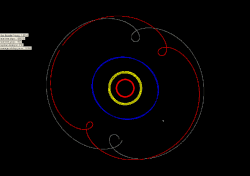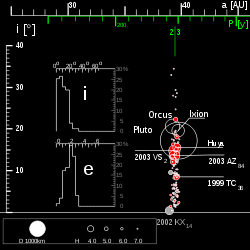Plutinus
The plutinos are trans-Neptunian objects that are in 3:2 orbital resonance with Neptune. This means that they make two orbits around the Sun while Neptune makes three orbits. For this reason, even if they cross the orbit of the giant planet, it cannot gravitationally expel them.
Since this resonance characteristic is shared with Pluto, these bodies were called plutinos, that is, "little plutos". From the moment that Pluto was reclassified as a dwarf planet in 2006, it was considered one of the plutinos.
Plutinos are about a quarter of the known Kuiper belt objects, located in its inner part. They are also the most populous known class of resonant trans-Neptunian objects. Apart from Pluto itself, the first plutino, (385135) 1993 RO, was discovered on September 16, 1993.
Orbits
Origin
Objects currently in mean orbital resonance with Neptune are thought to have initially followed a variety of independent heliocentric paths. As Neptune migrated outward early in the solar system's history, the bodies it approached would have scattered; during this process, some of them would have been captured in resonances. The 3:2 resonance is a low-order resonance and is therefore the strongest and most stable among all resonances. This is the main reason why which has a larger population than the other Neptunian resonances found in the Kuiper belt. The cloud of bodies with a low inclination beyond 40 astronomical units from the Sun, is the family of cubewanos, while the bodies with higher eccentricities (0.05 to 0.34) and semi-major axes close to the resonance of Neptune 3:2 they are mainly plutine.
Orbital characteristics
Although most plutinos have relatively low orbital inclinations, a significant fraction of these objects follow orbits similar to Pluto's, with inclinations in the range of 10–25º and eccentricities around 0.2-0.25. Such orbits result in many of these objects having perihelions near or even within the orbit of Neptune, while simultaneously having aphelions that bring them closer to the outer edge of the main Kuiper belt (where the objects meet in a 1:2 resonance). with Neptune, the twotinos).
The orbital periods of the plutinos cluster around 247.3 years (1.5 × the orbital period of Neptune), varying at most a few years from this value.
Unusual plugins include:
- 2005 TV189following the most inclined orbit (34.5o)
- (15875) 1996 TP66which has the most elliptical orbit (its eccentricity is 0.33), with the perihelium halfway between Uranus and Neptune
- (470308) 2007 JH43 follow an almost circular orbit
- 2002 VX130 lies almost perfectly on the ecliptic (inclination less than 1.5o)
Long-term stability
Pluto's influence on the other plutinos has historically been neglected due to its relatively small mass. However, the resonance width (the range of semi-axes compatible with the resonance) is very narrow and only a few times larger than Pluto's Hill sphere (gravitational influence). Consequently, depending on the original eccentricity, some plutinos will eventually be thrown out of resonance by interactions with Pluto. Numerical simulations suggest that the orbits of plutinos with an eccentricity between 10% and 30% less or greater than that of Pluto are not stable on giga-year time scales.
Orbital diagrams
The plutino family
The following list corresponds to some of the objects in the category of plutinos.
| Object | (a) UA | eccentricity (e) | inclination (i) Grades | perihelio (q) UA | afelio (Q) UA |
|---|---|---|---|---|---|
| (15875) 1996 TP66 | 39,71 | 0.34 | 5.7 | 26,38 | 53,05 |
| (19299) 1966 SZ4 | 39,82 | 0.26 | 4.7 | 29,57 | 50.07 |
| 1996 RR20 | 40,05 | 0.19 | 5.3 | 32,55 | 47,55 |
| 1993 SB | 39,55 | 32 | 1.9 | 26,91 | 52,18 |
| (15789) 1993 SC | 39,88 | 0.19 | 5.2 | 32,24 | 47,52 |
| (385135) 1993 RO | 39,61 | 0.20 | 3.7 | 31,48 | 47,73 |
| 1993 RP | 39,33 | 0.11 | 2.8 | 35,00 | 43,66 |
| (15810) 1994 JR1 | 39,43 | 0.12 | 3,8 | 34,76 | 44.11 |
| 1994 TB | 39,84 | 32 | 12.1 | 27,05 | 52,63 |
| 1995 HM5 | 39,37 | 0.25 | 4.8 | 29,48 | 49,26 |
| (24952) 1997 QJ4 | 39.65 | 0.22 | 16.5 | 30.83 | 48,47 |
| 1995 KK1 | 39,48 | 0.19 | 9,3 | 38.67 | 46,98 |
| (20108) 1995 QZ9 | 39,77 | 0.15 | 19.5 | 33,70 | 45,85 |
| 1995 YY3 | 39,39 | 0.22 | 0.4 | 30.70 | 48,08 |
| (118228) 1996 TQ66 | 39.65 | 0.13 | 14,6 | 34,59 | 44,71 |
| Pluto | 39,61 | 0.25 | 17.17 | 29,58 | 49.30 |
Contenido relacionado
Astronomical system of units
Proxima Centauri
Triton (satellite)
Nicolaus Copernicus
Hamal




